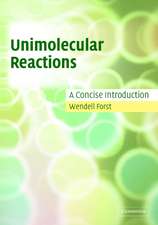Crystals as Giant Molecules: Lecture Notes in Chemistry, cartea 9
Autor A. Julgen Limba Engleză Paperback – sep 1978
Din seria Lecture Notes in Chemistry
-
 Preț: 96.74 lei
Preț: 96.74 lei - 18%
 Preț: 1123.35 lei
Preț: 1123.35 lei - 18%
 Preț: 776.72 lei
Preț: 776.72 lei - 18%
 Preț: 779.57 lei
Preț: 779.57 lei - 18%
 Preț: 1005.74 lei
Preț: 1005.74 lei - 18%
 Preț: 997.88 lei
Preț: 997.88 lei - 18%
 Preț: 1004.00 lei
Preț: 1004.00 lei - 18%
 Preț: 1136.30 lei
Preț: 1136.30 lei - 18%
 Preț: 1117.03 lei
Preț: 1117.03 lei - 18%
 Preț: 1006.55 lei
Preț: 1006.55 lei - 18%
 Preț: 903.62 lei
Preț: 903.62 lei -
 Preț: 377.73 lei
Preț: 377.73 lei -
 Preț: 395.63 lei
Preț: 395.63 lei - 18%
 Preț: 728.43 lei
Preț: 728.43 lei - 18%
 Preț: 782.57 lei
Preț: 782.57 lei - 18%
 Preț: 1112.78 lei
Preț: 1112.78 lei - 15%
 Preț: 688.13 lei
Preț: 688.13 lei - 15%
 Preț: 646.62 lei
Preț: 646.62 lei -
 Preț: 393.35 lei
Preț: 393.35 lei - 18%
 Preț: 1124.30 lei
Preț: 1124.30 lei -
 Preț: 384.86 lei
Preț: 384.86 lei -
 Preț: 383.71 lei
Preț: 383.71 lei -
 Preț: 378.71 lei
Preț: 378.71 lei -
 Preț: 384.09 lei
Preț: 384.09 lei -
 Preț: 387.42 lei
Preț: 387.42 lei -
 Preț: 388.90 lei
Preț: 388.90 lei -
 Preț: 393.35 lei
Preț: 393.35 lei -
 Preț: 384.09 lei
Preț: 384.09 lei -
 Preț: 377.73 lei
Preț: 377.73 lei -
 Preț: 382.95 lei
Preț: 382.95 lei -
 Preț: 384.70 lei
Preț: 384.70 lei - 15%
 Preț: 644.63 lei
Preț: 644.63 lei -
 Preț: 386.00 lei
Preț: 386.00 lei -
 Preț: 389.70 lei
Preț: 389.70 lei -
 Preț: 384.09 lei
Preț: 384.09 lei -
 Preț: 385.25 lei
Preț: 385.25 lei -
 Preț: 392.21 lei
Preț: 392.21 lei -
 Preț: 386.00 lei
Preț: 386.00 lei -
 Preț: 403.37 lei
Preț: 403.37 lei -
 Preț: 378.71 lei
Preț: 378.71 lei -
 Preț: 383.50 lei
Preț: 383.50 lei -
 Preț: 390.63 lei
Preț: 390.63 lei -
 Preț: 389.31 lei
Preț: 389.31 lei
Preț: 379.48 lei
Nou
Puncte Express: 569
Preț estimativ în valută:
72.61€ • 76.02$ • 60.08£
72.61€ • 76.02$ • 60.08£
Carte tipărită la comandă
Livrare economică 07-21 aprilie
Preluare comenzi: 021 569.72.76
Specificații
ISBN-13: 9783540089469
ISBN-10: 3540089462
Pagini: 144
Ilustrații: VIII, 136 p.
Dimensiuni: 155 x 235 x 8 mm
Greutate: 0.21 kg
Ediția:Softcover reprint of the original 1st ed. 1978
Editura: Springer Berlin, Heidelberg
Colecția Springer
Seria Lecture Notes in Chemistry
Locul publicării:Berlin, Heidelberg, Germany
ISBN-10: 3540089462
Pagini: 144
Ilustrații: VIII, 136 p.
Dimensiuni: 155 x 235 x 8 mm
Greutate: 0.21 kg
Ediția:Softcover reprint of the original 1st ed. 1978
Editura: Springer Berlin, Heidelberg
Colecția Springer
Seria Lecture Notes in Chemistry
Locul publicării:Berlin, Heidelberg, Germany
Public țintă
ResearchCuprins
I. General Results Concerning Molecules.- 1. The Molecular Orbitals.- 2. Localization of Molecular Orbitals and the Hybridization Concept.- 3. Shapes of Some Usual Hybrid Atomic Orbitals.- 4. Total Energy and Bond Energy.- 5. Prediction of Molecular Geometry.- 6. Fundamental Remarks Concerning the Alignment of Orbitals.- 7. Electron Charges and Bond Polarities.- II. Application to Crystals.- 1. The Two Large Classes of Crystals.- 2. Molecular Crystals.- 3. Three-dimensional Macromolecular Crystals.- 4. Note: The Coordination Number.- 5. Cohesive Energy in Tridimensional Macromolecular Crystals.- III. Electron Charges and Ionicity in Macromolecular Crystals.- 1. Methods of Calculating Electron Charges in Crystal.- 2. General Results.- 3. Definition of Bond-Ionicity in a Crystal.- 4. Application of the Ionicity Notion to the Determination of the Hardness of a Crystal.- 5. Application to the Determination of Electron Charges.- 6. Discussion of the Results.- 7. The Ionic Approximation.- 8. Deformation of Ions in the Ionic Model.- IV. The Crystal Arrangement.- 1. Preliminary Remarks.- 2. Inadequacy of the Classical Criterion Derived from the Ionic Radii Ratio.- 3. Quantum Study of Relative Stabilities of Various Arrangements in Alkali Halides.- 4. Cohesive Energy and Crystal Arrangement in Metals.- 5. Why is Lithium a Metal?.- 6. Why does Lithium adopt the bcc Arrangement?.- 7. Why does Cubium not exist?.- 8. Hydrogen.- 9. Copper, Silver, and Gold.- 10. Alkaline-earth Metals and Semi-metals.- 11. Transition Metals.- 12. Crystals Arrangements Allowing a Description in Terms of Localized Orbitals.- 13. Oxides Arrangements.- 14. Role of Hybridization.- 15. Importance of the Alignment of the Orbitals and Effects of Distortions.- 16. Conjugation Effect in Many Crystals.- V. Distortions Caused by the Existence of Faces and the Finite Sizes of Crystals.- 1. Classic Results and Few Recent Experimental Facts.- 2. Examples of Quantum Treatments.- 3. Vacancy Problem.- VI. External Shapes of Crystals.- 1. Metals.- 2. Other Crystals.- 3. Twin Crystals.- Conclusions and Various Outlooks.- Appendix A: The self-consistent field method and the Hückel approximation.- Appendix B: Expressions of hybrid atomic Orbitals.- Appendix C: An example of molecular orbital localization.- Appendix D: Mineral hardness — Improved Mohs scale.- References.- Formula Index.











